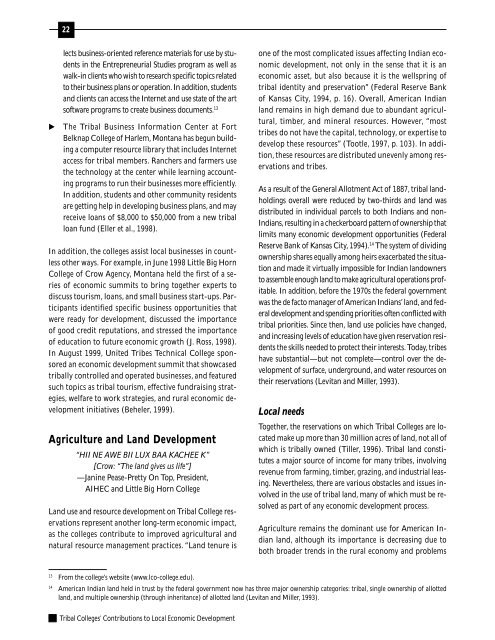Tribal College Contributions to Local Economic Development
Tribal College Contributions to Local Economic Development
Tribal College Contributions to Local Economic Development
- No tags were found...
Create successful ePaper yourself
Turn your PDF publications into a flip-book with our unique Google optimized e-Paper software.
22lects business-oriented reference materials for use by studentsin the Entrepreneurial Studies program as well aswalk-in clients who wish <strong>to</strong> research specific <strong>to</strong>pics related<strong>to</strong> their business plans or operation. In addition, studentsand clients can access the Internet and use state of the artsoftware programs <strong>to</strong> create business documents. 13The <strong>Tribal</strong> Business Information Center at FortBelknap <strong>College</strong> of Harlem, Montana has begun buildinga computer resource library that includes Internetaccess for tribal members. Ranchers and farmers usethe technology at the center while learning accountingprograms <strong>to</strong> run their businesses more efficiently.In addition, students and other community residentsare getting help in developing business plans, and mayreceive loans of $8,000 <strong>to</strong> $50,000 from a new triballoan fund (Eller et al., 1998).In addition, the colleges assist local businesses in countlessother ways. For example, in June 1998 Little Big Horn<strong>College</strong> of Crow Agency, Montana held the first of a seriesof economic summits <strong>to</strong> bring <strong>to</strong>gether experts <strong>to</strong>discuss <strong>to</strong>urism, loans, and small business start-ups. Participantsidentified specific business opportunities thatwere ready for development, discussed the importanceof good credit reputations, and stressed the importanceof education <strong>to</strong> future economic growth (J. Ross, 1998).In August 1999, United Tribes Technical <strong>College</strong> sponsoredan economic development summit that showcasedtribally controlled and operated businesses, and featuredsuch <strong>to</strong>pics as tribal <strong>to</strong>urism, effective fundraising strategies,welfare <strong>to</strong> work strategies, and rural economic developmentinitiatives (Beheler, 1999).Agriculture and Land <strong>Development</strong>“HII NE AWE BII LUX BAA KACHEE K”[Crow: “The land gives us life”]—Janine Pease-Pretty On Top, President,AIHEC and Little Big Horn <strong>College</strong>Land use and resource development on <strong>Tribal</strong> <strong>College</strong> reservationsrepresent another long-term economic impact,as the colleges contribute <strong>to</strong> improved agricultural andnatural resource management practices. “Land tenure isone of the most complicated issues affecting Indian economicdevelopment, not only in the sense that it is aneconomic asset, but also because it is the wellspring oftribal identity and preservation” (Federal Reserve Bankof Kansas City, 1994, p. 16). Overall, American Indianland remains in high demand due <strong>to</strong> abundant agricultural,timber, and mineral resources. However, “mosttribes do not have the capital, technology, or expertise <strong>to</strong>develop these resources” (Tootle, 1997, p. 103). In addition,these resources are distributed unevenly among reservationsand tribes.As a result of the General Allotment Act of 1887, tribal landholdingsoverall were reduced by two-thirds and land wasdistributed in individual parcels <strong>to</strong> both Indians and non-Indians, resulting in a checkerboard pattern of ownership thatlimits many economic development opportunities (FederalReserve Bank of Kansas City, 1994). 14 The system of dividingownership shares equally among heirs exacerbated the situationand made it virtually impossible for Indian landowners<strong>to</strong> assemble enough land <strong>to</strong> make agricultural operations profitable.In addition, before the 1970s the federal governmentwas the de fac<strong>to</strong> manager of American Indians’ land, and federaldevelopment and spending priorities often conflicted withtribal priorities. Since then, land use policies have changed,and increasing levels of education have given reservation residentsthe skills needed <strong>to</strong> protect their interests. Today, tribeshave substantial—but not complete—control over the developmen<strong>to</strong>f surface, underground, and water resources ontheir reservations (Levitan and Miller, 1993).<strong>Local</strong> needsTogether, the reservations on which <strong>Tribal</strong> <strong>College</strong>s are locatedmake up more than 30 million acres of land, not all ofwhich is tribally owned (Tiller, 1996). <strong>Tribal</strong> land constitutesa major source of income for many tribes, involvingrevenue from farming, timber, grazing, and industrial leasing.Nevertheless, there are various obstacles and issues involvedin the use of tribal land, many of which must be resolvedas part of any economic development process.Agriculture remains the dominant use for American Indianland, although its importance is decreasing due <strong>to</strong>both broader trends in the rural economy and problems13From the college’s website (www.lco-college.edu).14American Indian land held in trust by the federal government now has three major ownership categories: tribal, single ownership of allottedland, and multiple ownership (through inheritance) of allotted land (Levitan and Miller, 1993).<strong>Tribal</strong> <strong>College</strong>s’ <strong>Contributions</strong> <strong>to</strong> <strong>Local</strong> <strong>Economic</strong> <strong>Development</strong>
















